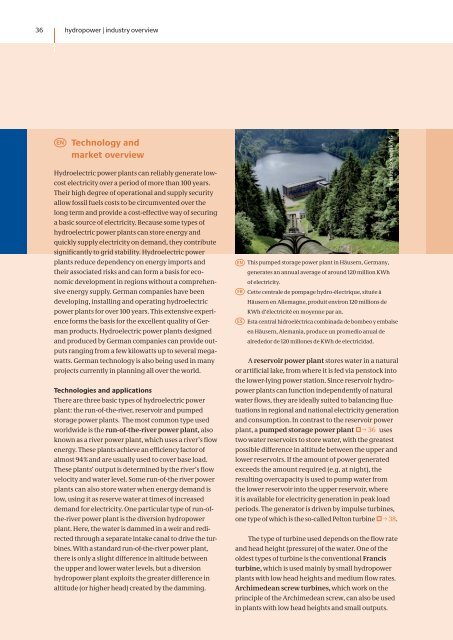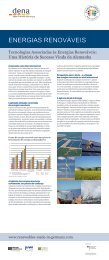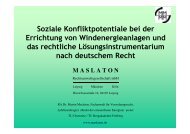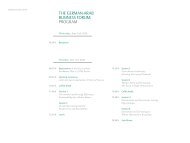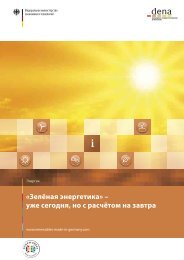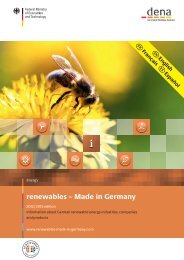renewables – Made in Germany
renewables – Made in Germany
renewables – Made in Germany
Create successful ePaper yourself
Turn your PDF publications into a flip-book with our unique Google optimized e-Paper software.
36 hydropower | <strong>in</strong>dustry overview<br />
g Technology and<br />
market overview<br />
Hydroelectric power plants can reliably generate lowcost<br />
electricity over a period of more than 100 years.<br />
Their high degree of operational and supply security<br />
allow fossil fuels costs to be circumvented over the<br />
long term and provide a cost-effective way of secur<strong>in</strong>g<br />
a basic source of electricity. Because some types of<br />
hydroelectric power plants can store energy and<br />
quickly supply electricity on demand, they contribute<br />
significantly to grid stability. Hydroelectric power<br />
plants reduce dependency on energy imports and<br />
their associated risks and can form a basis for economic<br />
development <strong>in</strong> regions without a comprehensive<br />
energy supply. German companies have been<br />
develop<strong>in</strong>g, <strong>in</strong>stall<strong>in</strong>g and operat<strong>in</strong>g hydroelectric<br />
power plants for over 100 years. This extensive experience<br />
forms the basis for the excellent quality of German<br />
products. Hydroelectric power plants designed<br />
and produced by German companies can provide outputs<br />
rang<strong>in</strong>g from a few kilowatts up to several megawatts.<br />
German technology is also be<strong>in</strong>g used <strong>in</strong> many<br />
projects currently <strong>in</strong> plann<strong>in</strong>g all over the world.<br />
Technologies and applications<br />
There are three basic types of hydroelectric power<br />
plant: the run-of-the-river, reservoir and pumped<br />
storage power plants. The most common type used<br />
worldwide is the run-of-the-river power plant, also<br />
known as a river power plant, which uses a river’s flow<br />
energy. These plants achieve an efficiency factor of<br />
almost 94 % and are usually used to cover base load.<br />
These plants’ output is determ<strong>in</strong>ed by the river’s flow<br />
velocity and water level. Some run-of-the river power<br />
plants can also store water when energy demand is<br />
low, us<strong>in</strong>g it as reserve water at times of <strong>in</strong>creased<br />
demand for electricity. One particular type of run-ofthe-river<br />
power plant is the diversion hydropower<br />
plant. Here, the water is dammed <strong>in</strong> a weir and redirected<br />
through a separate <strong>in</strong>take canal to drive the turb<strong>in</strong>es.<br />
With a standard run-of-the-river power plant,<br />
there is only a slight difference <strong>in</strong> altitude between<br />
the upper and lower water levels, but a diversion<br />
hydropower plant exploits the greater difference <strong>in</strong><br />
altitude (or higher head) created by the damm<strong>in</strong>g.<br />
Schluchseewerk AG<br />
g This pumped storage power plant <strong>in</strong> Häusern, <strong>Germany</strong>,<br />
gene rates an annual average of around 120 million KWh<br />
of electricity.<br />
f Cette centrale de pompage hydro-électrique, située à<br />
Häusern en Allemagne, produit environ 120 millions de<br />
KWh d‘électricité en moyenne par an.<br />
e Esta central hidroeléctrica comb<strong>in</strong>ada de bombeo y embalse<br />
en Häusern, Alemania, produce un promedio anual de<br />
alrededor de 120 millones de KWh de electricidad.<br />
A reservoir power plant stores water <strong>in</strong> a natural<br />
or artificial lake, from where it is fed via penstock <strong>in</strong>to<br />
the lower-ly<strong>in</strong>g power station. S<strong>in</strong>ce reservoir hydropower<br />
plants can function <strong>in</strong>dependently of natural<br />
water flows, they are ideally suited to balanc<strong>in</strong>g fluctuations<br />
<strong>in</strong> regional and national electricity generation<br />
and consumption. In contrast to the reservoir power<br />
plant, a pumped storage power plant �p 36 uses<br />
two water reservoirs to store water, with the greatest<br />
possible difference <strong>in</strong> altitude between the upper and<br />
lower reservoirs. If the amount of power generated<br />
exceeds the amount required (e.g. at night), the<br />
result<strong>in</strong>g overcapacity is used to pump water from<br />
the lower reservoir <strong>in</strong>to the upper reservoir, where<br />
it is available for electricity generation <strong>in</strong> peak load<br />
periods. The generator is driven by impulse turb<strong>in</strong>es,<br />
one type of which is the so-called Pelton turb<strong>in</strong>e �p 38.<br />
The type of turb<strong>in</strong>e used depends on the flow rate<br />
and head height (pressure) of the water. One of the<br />
oldest types of turb<strong>in</strong>e is the conventional Francis<br />
turb<strong>in</strong>e, which is used ma<strong>in</strong>ly by small hydropower<br />
plants with low head heights and medium flow rates.<br />
Archimedean screw turb<strong>in</strong>es, which work on the<br />
pr<strong>in</strong>ciple of the Archimedean screw, can also be used<br />
<strong>in</strong> plants with low head heights and small outputs.


